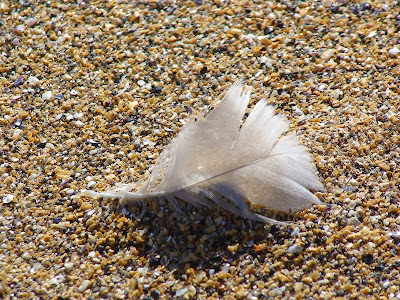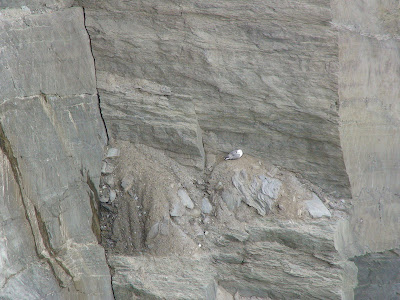The peninsulas of County Kerry are lovely enough, and their fame is considerable - so much so that Eileen and I expected our March 2012 tour of Ireland to concentrate on the southwest alone. However, one of the advantages of being on your own, in a rental car, in a country full of B&Bs, and without specific plans is that you can change your itinerary. Eileen and I decided, instead of lingering in the Southwest, to continue north and make a circuit around the island. I'm glad we did. To the north of County Kerry lies County Clare, and its seacoast is, if anything, even more rugged and magnificent than in the Southwest.
We found this out once we turned North from the base of the Dingle Peninsula and drove down to Loop Head, County Clare's southwesternmost point. We followed the path out to its famous lighthouse, finding ourselves increasingly high above the sea as we walked.
Ocean winds over the point hold the vegetation on the cliff top to a thin, clinging mat, sprinkled with a few hardy plants like Common Scurvygrass (Cochlearia officinalis) - not a grass, but a member of the same family as cabbage (Brassicaceae) and once, as its name suggests, a popular preventative against scurvy.
From the heights, we could look over the sea at distant pods of Bottlenose Dolphin (Tursiops truncatus) and the enormous, far-off dorsal fins of the second largest fish in the world, the Basking Shark (Cetorhinus maximus). Eileen even got to see a basking shark leaping out of the water, a sight I unfortunately missed. One of the problems of being on a high cliff, though, is that the marine life below you is a long distance away.
On the north coast of Loop Head, not far from Kilkee, things became easier. a stop to see the natural arch near Moveen brought us much closer to the ocean, and when I scrambled around to an adjoining inlet I was startled to see a Basking Shark foraging only a few meters from shore.
The Basking Shark, like the even larger Whale Shark (Rhincodon typus), is a filter feeder. It finds food by swimming slowly beneath the surface, its cavernous mouth agape, straining small organisms from the seawater through its gill rakers. That was, obviously, what this fish was doing, though all I could see from my perch on the rocks was the outline of a massive body just visible beneath the surface, a protruding dorsal fin, and the occasional glimpse of a tail. All the same, this was certainly my most thrilling wildlife encounter in Ireland.
Migrating Basking Sharks – An Liamhán Gréine, "Sun or Sail Fish" – are fairly common sight along the northern and western coasts of Ireland. They are docile creatures, and may allow swimmers a very close approach (there are a number of videos on YouTube to prove it). Unfortunately, we have returned the favour by grossly overfishing them, mostly for their oil-rich livers and their fins. This was one of the first sharks to be added to the Appendices of the Convention on International Trade In Endangered Species of Wild Fauna and Flora (CITES), and one of the particular pleasures of seeing wild Basking Sharkss was in knowing that, as part of the Species Survival Network (SSN), I had had some role in lobbying for, and winning, this protection.
Even closer than the sharks and dolphins were Northern Fulmars (Fulmaris glacialis) breeding along the rock ledges. Though the word "fulmar" means "foul gull" - a reference to their habit of expressing their displeasure by projectile-vomiting their stomach fluids - these are not gulls, but the most accessible North Atlantic members of the shearwater and petrel family (Procellariidae).
I found a good vantage point, and spent a considerable time watching nesting pairs displaying to each other, squawking and nibbling at each other's bills - all part of a day's work maintaining the pair bond. Eileen had some difficulty tearing me away.
By now, though, it was getting late in the day, and we had to make tracks if we wanted to see the most spectacular coastline of all: the famous Cliffs of Moher, some distance further north. they are such an extraordinary sight that tourist buses regularly make the trips from Dublin, on the other side of Ireland, to see them.
We spent the night in the nearby town of Doolin enjoying traditional Irish music in a local pub (well, you have to do that sort of thing at least once, and Doolin is famous for it).
The next morning - April 3, 2012 - we continued our journey northward through County Clare. In the county's northwest we found not cliffs, but dunes running down to sandy beaches dotted with flat, weed-covered stones.
Fanore Beach, where Eileen is standing in this photo, is popular with swimmers - though admittedly not at the time of year we were there!
After Eileen retreated to the comfort of our car, I headed down to the beach to see what I could find on clinging to the rocks before they were covered by the incoming tides. There were seaweeds, of course…
…in particular, lots of Bladder Wrack (Fucus vesiculosus), its fronds studded with the pea-sized bladders that give it its name….
…and its relative Spiral wrack (Fucus spiralis).
Many of the rocks were covered with colonies of Common Mussel (Mytilus edulis), the same species frequently found in wine sauce ("edulis" means "edible").
Where the mussels hadn't completely taken over the surface of the stones I could find Common Limpets (Patella vulgata).
Little tide pools, in hollows in the rock surface that could hold water, provided shelter for creatures that found not survive exposure to the air (as well as, I'm afraid, odd bits of plastic fish net and other junk).
Just out of the water, sea anemones appeared as shrunken gelatinous blobs, their tentacles tucked safely out of reach.
By now the tide was starting to creep in. I headed back across the sand, pausing to photograph a last few remnants of coastal life: a Dog Whelk (Nucella lapillus), the footprints of a wandering seabird, and a windblown feather.




.jpg)



.jpg)
.jpg)
.jpg)
.jpg)
.jpg)
.jpg)
.jpg)
.jpg)
.jpg)
.jpg)








.jpg)
.jpg)
.jpg)
.jpg)
.jpg)
.jpg)
.jpg)

.jpg)
.jpg)
.jpg)








.jpg)
.jpg)
.jpg)
.jpg)
.jpg)



.jpg)








.jpg)










.jpg)
.jpg)
.jpg)
.jpg)
.jpg)
.jpg)
.jpg)
.jpg)
.jpg)

